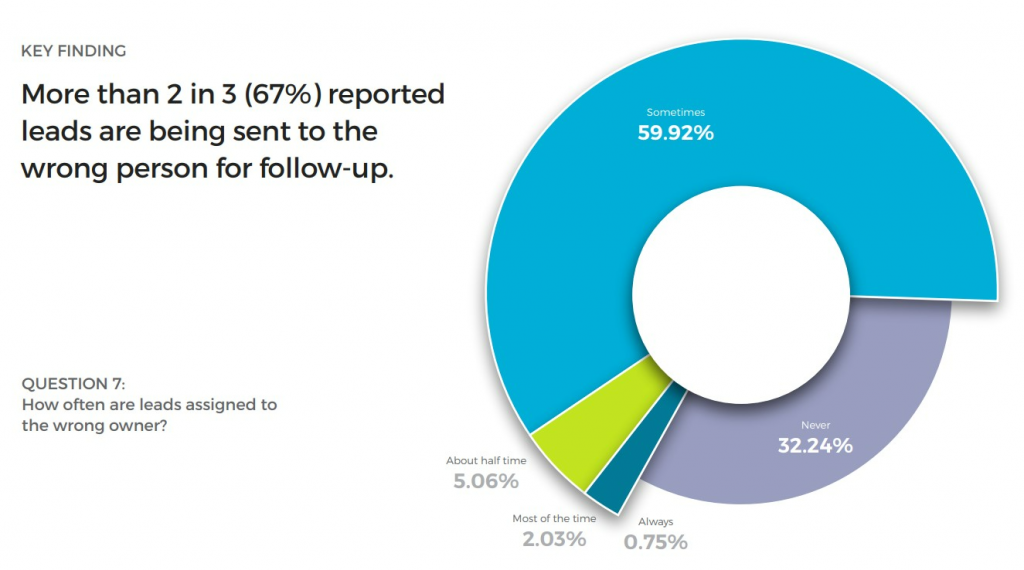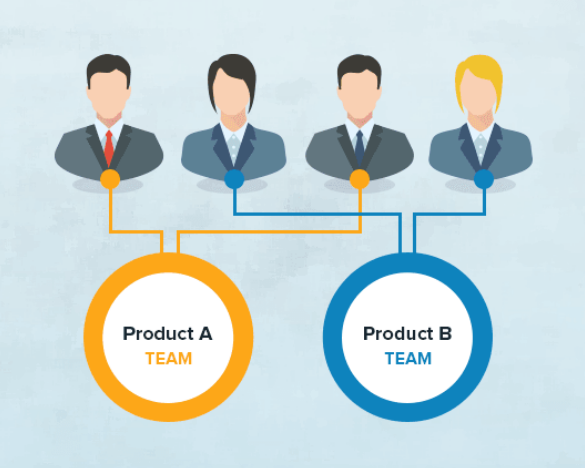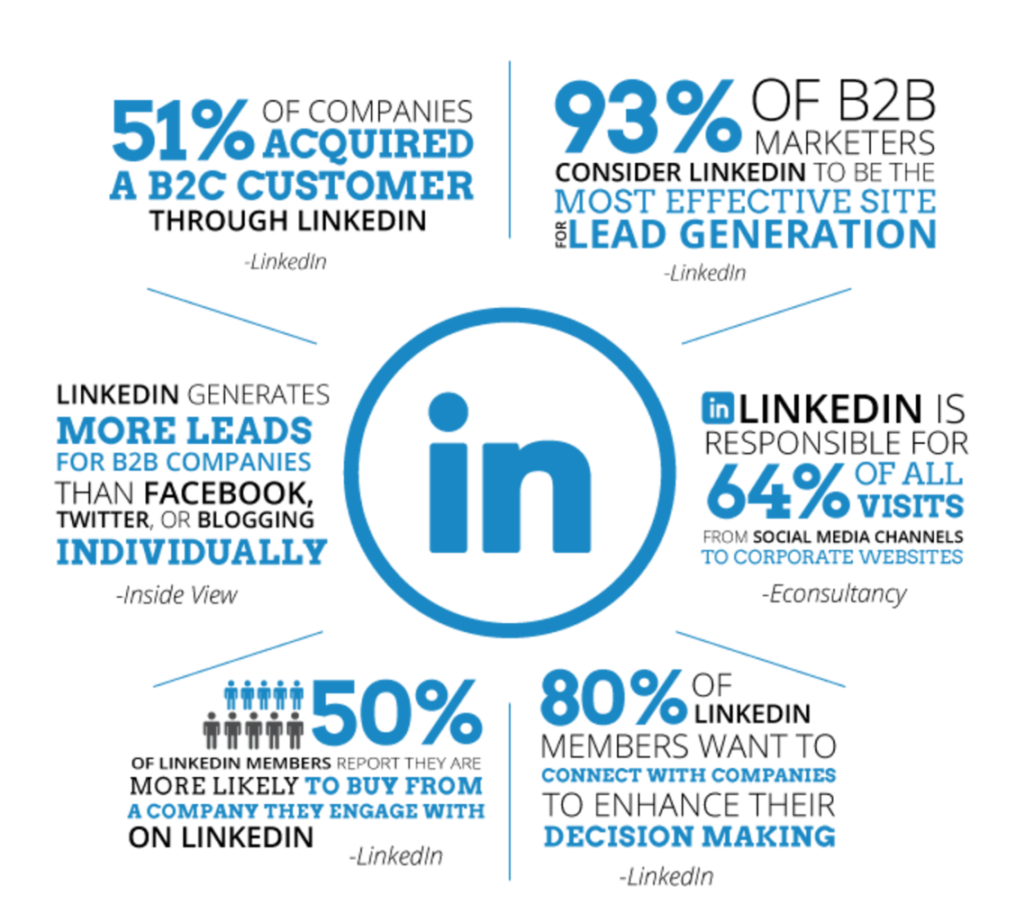Lead routing
Growing from a small niche company to a large-scale business means attracting all sorts of customers. But with more leads comes more responsibility. You might be thinking, “How do I convert them all?” Well, the first step is to make sure you’re reaching out to them promptly. Otherwise, they might get scooped up by your competitors.
Waiting for just 5 minutes can decrease your conversion rates by 8X. But let’s be real, that’s a tough goal to meet. In fact, more than 99% of companies fail to respond within this timeframe, with 57,1% of initial contacts with leads happening after more than a week!
Thankfully, lead routing can help solve this problem. Salespeople use this practice to ensure the right prospect gets to the right person on your team at the right time. This saves valuable time and resources while scaling up your sales strategy.
But here’s the catch. According to the State of B2B Lead Management 2022 report, 67% of leads are assigned to the wrong owner. So, it’s crucial to understand what lead routing is and how it works to ensure its effectiveness.

What is lead routing?
When you have a whole team of sales reps, deciding who should handle each lead can get confusing. That’s what lead routing is all about. To be exact, lead routing, also known as a lead assignment, is the process of distributing incoming leads among sales reps, usually done automatically using lead routing software.
Depending on how your leads are collected and their intended use, the lead routing process may differ. Still, the primary goal is the same — to respond to as many leads as possible in the shortest amount of time.
The easiest way to manage your lead routing process is to make an alphabetical list of your sales reps and assign leads based on the sales rep’s position in the list. A more effective approach is to assign leads based on specific criteria, such as your reps’ geographic location, industry expertise, or potential deal size.
Proper lead routing management ensures high levels of responsiveness, which means you’ll lose fewer potential leads to your competitors.
How to improve lead routing?
To avoid leads being assigned to the wrong person, set up a solid lead routing system within your sales team. This involves planning how leads should be segmented, qualified, assigned, nurtured, and more. Here are some common practices you can implement for advanced lead routing.
Select proper lead routing criteria for assigning a lead
To make sure your lead gets to the right person, apply specific criteria for the lead assignment. This may seem complicated, but it’s essentially like segmenting your leads based on different factors:
- Company size. This is particularly useful if your sales team can be divided based on the size of the companies your sales reps serve (small businesses, startups, mid-size companies, enterprise-level companies).
- Location. If you have a large distributed team, it’s crucial to route leads based on your sales reps’ location or region. For smaller sales teams, local lead routing can help establish local connections. Say, your lead works from home in Frankfurt, but their headquarters are in Berlin. Who should you assign this lead to? Should you connect this lead with someone in Frankfurt or elsewhere in Germany? Give it a thought together with your sales team.
Pro-tip! To avoid confusion, double-сheck where your leads are based and consider using automated solutions such as Snov.io Email Finder to filter leads by name, industry, size, and location.
- Industry. This means routing leads to sales reps with expertise in that area. It’s like assigning a detective specializing in art theft cases to a museum burglary case – they know their stuff!
- Lead score. Companies with complex sales models use lead scoring for advanced lead routing. By assigning a value or score to each lead based on criteria such as company size, location, or value, you can streamline the lead assignment process.
Pro-tip! With automated solutions such as CRM or similar software, you can automate the process and focus on personalization-based tasks. The system will evaluate potential customers, assign points, and automatically assign them to the sales department. This can make your company processes more efficient and increase overall productivity.
Consider your team’s strengths and weaknesses
Think of your sales team as a group of superheroes, each with their own special power. Some can lift heavy weights, while others can run lightning-fast. And just like superheroes, they can do amazing things when paired with the right lead.
To make sure you’re pairing your sales reps with the right leads, take the time to understand their strengths. Some may be able to work wonders with leads in a specific industry, while others may have a knack for dealing with particular job titles or company sizes.
Once you’ve got a handle on your team’s strengths, use lead grading to determine the level of expertise needed for each lead. By sorting your leads based on anticipated interests and assigning them to the right sales rep as soon as possible, you’ll increase your conversions and revenues. Plus, your sales team will appreciate not being matched with leads that aren’t the right fit for their skills.

Back up your lead routing process with more technology
Advanced lead routing is impossible without gathering as much information as possible about your leads before reaching out to them. This can be a challenging task, given that leads can come from a variety of social media channels, marketing campaigns, and third-party sources. But fear not; there are automated solutions available to help you get the job done!
One of the most valuable platforms for B2B lead generation is LinkedIn. With its wealth of professional information, you can gain insight into a lead’s industry, job title, and even interests. However, manually searching for leads on LinkedIn can be a time-consuming process.

That’s where Snov.io LI Prospect Finder comes in handy. This Chrome extension simplifies the search process, allowing you to quickly and easily extract relevant lead data.
Once you’ve gathered the information, be sure to integrate it into your CRM system to streamline your lead routing process. With better data and more efficient processes, your sales team will be well-equipped to turn leads into customers.
Don’t go overboard
When it comes to lead routing, it’s important to strike a balance between providing enough information and overwhelming your sales team. If you include too many irrelevant details in your lead profiles, your reps might only focus on a select few prospects while ignoring others that could still be valuable. This hand-picking could eventually lead to lower conversion rates and hurt your long-term sales goals.
Benefits of advanced lead routing
Sales are like a machine, and without proper lead routing, errors are bound to happen. But don’t worry, setting up a solid lead routing system can do wonders for your business! Here are just a few benefits:
- Faster response times. A good lead routing system can instantly assign leads to sales reps who can respond ASAP. The more time you save on the initial response, the more time you get to re-route leads to another sales rep if needed.
- Better lead organization and distribution. With a lead routing system, you can organize your leads by location, behavior, communication channel, engagement time, you name it! This helps you identify leads you’ve contacted before and weed out the ones who aren’t interested in your product.
- More accurate data. Sales reps are typically very busy, and mistakes happen. But with a well-established lead routing system, data analysis is easier, and forecasting is improved, thanks to effective delegation.
- Improved rapport with customers. Lead routing involves constant communication, including meeting scheduling and follow-ups. It also enables sales reps to identify cold leads and automate follow-ups to warm them up.
- Better resource use. When the right leads are assigned to the right reps, the time and resources of the company are used effectively, bringing higher conversions and happier customers whose needs were totally met.
Wrapping up
Lead routing might seem daunting at first, but once set, it might become a total game-changer for your business. A comprehensive, integrated lead routing system ensures that your response time is optimized, eliminating the costly response lag and streamlining your conversions and sales.
















